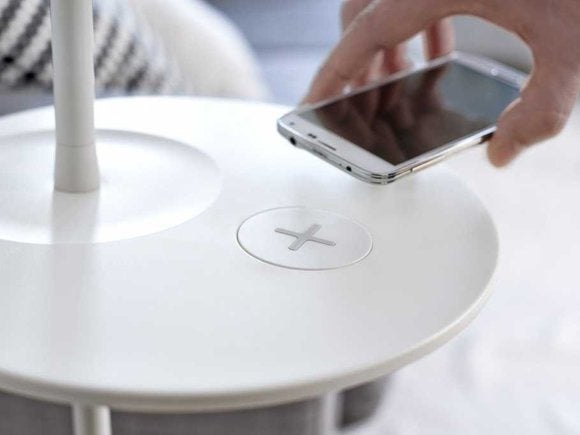Apple’s decision to put its weight behind the Wireless Power Consortium's Qi wireless power standard will kick-start the entire industry, experts say. But what is it, how does it work, and where might we be going?
Muscling in on wireless charging
Apple didn’t invent Wi-Fi, but when it became the first big computer company to build support for the standard into its iBook notebook Mac, it kick-started the standard into mainstream adoption. It’s doing it again, with wireless charging.
Thanks to their all-glass backs, iPhone’s 8, 8 Plus and X will all be compatible with Qi-based wireless charging products, such as pads from Belkin, Mophie and others.
Qi is an open standard run by the Wireless Power Consortium that was agreed on in 2008. Apple has been using the tech for some time with Apple Watch, and it joined the WPC earlier this year.
[Also read: iPhone X & Face ID: Everything you need to know]
You’ll find these things in coffee shops, public libraries and a range of other public spaces. You can purchase Qi charging mats from all over the place — Swedish giant IKEA even makes furniture that integrates these mats.
Powermat wireless charging systems are also compatible with the new iPhones. These solutions are in play at big retailers such as Starbucks in the U.S. and abroad, and the company claims over 12,000 public charging spots are in use. The technology is also installed inside over 3.2 million vehicles.
There is a building swell of support to use these solutions on a larger scale to recharge electronic vehicles — giant power charging pads in parking spaces, for example.
How wireless charging works
In this case, wireless charging means you recharge your device by placing it on a compatible mat (which is itself, ironically, wired).
The Qi system used inductive charging in which power is transmitted over an electromagnetic field from the pad to the device. When it reaches the iPhone, a built-in receiver converts the signal to current. Here’s a good technical explanation.
The idea is that you can leave your iPhone, iPad, Apple Watch, Apple Glass on the pad, and it will be charged up.
It isn’t as fast as the power generated when you use the Fast Power mode on the new iPhones, but it is a whole lot more convenient than flailing about for a cable and finding you have lint stuck in your iPhone's power port.
Typically, Apple also wants to create its own version of Qi.
The company’s AirPower solution will charge up to three devices at once, but it won’t be available until next year. That’s because Apple needs to build a way to use Qi to recharge multiple devices on a single mat.
Analyst Patrick Moorhead of Moor Insights notes: “In true Apple form, they took it a step further to help solve a very real issue and that is how to charge multiple devices at the same time. AirPower, available next year, will simultaneously charge the iPhone, Watch Series 3 and a new AirPod case. This is wireless charging done right.”
Apple's involvement: cause and effect
While Qi has been around for almost a decade, it’s actual deployment is relatively low.
That’s not for lack of trying.
Qi first appeared on a Palm smartphone in 2009. Manufacturers, including Nokia and LG, have also supported it for years. The Wireless Power Consortium claims around 90 mobile device models support the standard, but a Powermat press release confirms that means just 500 million devices are compatible with it.
In comparison, Apple’s debut means the Qi population is about to climb by almost 50 percent — over 227 million compatible iPhones will be sold in the next 12 months.
That's market muscle in action.
Apple going all in with Qi will very likely also prompt the slow disappearance of the competing AirFuel Alliance standard. That standard accounts for just 10 percent of the market and will now see its market share shrink in comparison to Qi.
“Apple has the gravitas and marketing clout to kick-start widespread adoption of an area where others have failed,” Geoff Blaber, an analyst at CCS Insight, said.
Reaction to Apple's move into wireless charging
Apple’s introduction certainly struck a chord.
Social media analytics company Talkwalker identified 21,500 social media conversations concerning iPhone support for Qi during the two-hour iPhone X announcement. (Overall, 75 percent of social media conversations about Apple's news during the launch were positive.)
Dan Bladen, CEO of U.K. wireless industry startuo Chargifi called Apple’s decision to support wireless charging a “catalyst for driving the mass deployment” of wireless charging.
“When Apple does something the rest of the world sits up and takes notice, and their competitors generally follow,” he said.
Spoiler alert
So, can the Qi standard rest on its laurels? I don’t think so.
I suspect that now Apple has shown its interest in wireless charging technology, it will spend some of its vast R&D budget in attempting to enhance the standard.
One thing it might attempt is to figure out how to also use uncoupled wireless energy technologies, such as those being developed by Energous, though I remain convinced such solutions are some way down the line.
However, Apple seems to be well on target on another unstated mission: to create electronic devices that lack any moving parts, cables or exposed ports.
Google+? If you use social media and happen to be a Google+ user, why not join AppleHolic's Kool Aid Corner community and join the conversation as we pursue the spirit of the New Model Apple?
Got a story? Drop me a line via Twitter. I'd like it if you chose to follow me there so I can let you know when fresh items are published here first on Computerworld.






